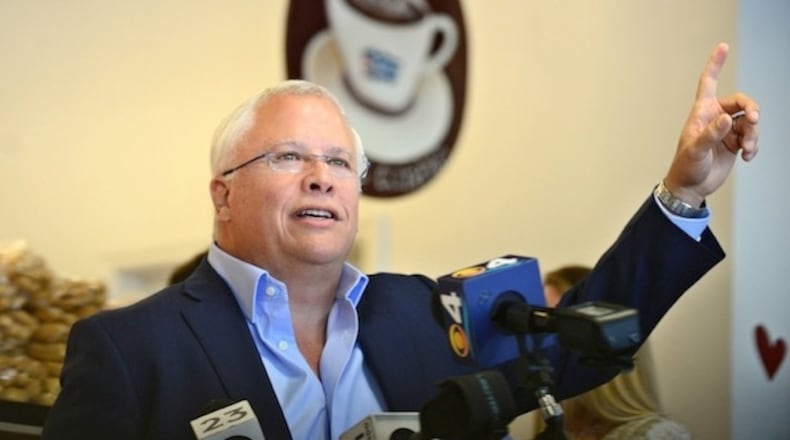TALLAHASSEE — In the must-win state of Florida, Democrats are seeing their numerical advantage in voters slowly wither away — a trend that could make a third straight presidential election victory in 2016 more challenging.
"It worries me," said Democratic strategist Steve Schale, a veteran of both of President Barack Obama's successful Florida campaigns who said part of the problem lies with the party itself.
"There has not been a sustained effort at voter registration," Schale said.
In Florida, the race between Republican Donald Trump and Democrat Hillary Clinton will be the supreme test of both parties' ability to get as many of their voters to the polls as possible, at a time when the Democrats' share of the voter pool keeps shrinking, making the state a slightly lighter shade of blue.
"We're seeing the beginning of a wave," said Blaise Ingoglia, chairman of the Republican Party of Florida and a state representative from Spring Hill, who considers Obama's back-to-back Florida victories as outliers. "This is a pretty red state. We just happened to lose the past two presidential elections."
The Democratic and Republican parties in Florida have been weakened by a surge in voters opting to register with no party affiliation, or NPA.
But a review of statewide registration data over the past decade shows that the expansion of the NPA pool of voters has been largely at the expense of Democrats. Republicans have withstood the NPA wave and its share of the electorate has remained relatively constant.
In 2008, the year of Obama's first Florida victory, Democrats accounted for 42 percent of all voters and the party had a numerical advantage of more than 650,000 voters that fall. Republicans made up 36 percent of the voter pool in 2008.
By June 1 of this year, Democratic registration had slipped 4 percentage points to 38 percent and the party's edge in raw numbers stood at fewer than 260,000 voters statewide, a modern low. But during that same eight-year period, the Republican share remains just below 36 percent, at 35.8.
Florida is seeing a surge of enthusiasm about the upcoming election, and that, too, is helping Republicans more than Democrats, in part because of Trump.
In the six months ending May 31, 311,000 voters joined the rolls or changed their party.
That total included 184,000 Republicans and 117,000 Democrats. At the same time, hundreds of thousands of voters who were NPAs or Democrats switched to the Republican Party so they could vote in the closed GOP presidential preference primary in March.
The state's fluid demographics to a more racially and ethnically diverse population should favor Democrats, especially in the urban centers of Tampa Bay, Orlando and South Florida.
But those voters — young, Hispanic, African-American and new to Florida — are also more likely to register with no party affiliation.
"There is some disconnect happening within the Democratic Party among voters who are traditionally part of our voting base," Schale said.
At the same time, whites have been fleeing the Democratic Party in significant numbers. The percentage of Florida voters who are white and Democratic has shrunk from 62 percent in 2008 to 51 percent today.
In 1994, the last year a Democrat was elected governor in Florida, Democrats made up nearly 50 percent of the overall electorate of 6.6 million voters and Republicans made up 42 percent. Today, the state has more than 12 million voters. Democrats account for 38 percent and Republicans 36 percent.
For the past two decades, the Democrats' advantage in voter registration has been somewhat illusory. That's because many of the party's rural voters support Republicans, especially in presidential elections.
But the slow, steady evaporation of the party's registration advantage, even on paper, underscores the need for Democrats to ramp up voter registration efforts after Clinton is nominated at the party's Philadelphia convention — if they hope to replicate Obama's successes.
"We're still the bigger party in Florida and the bigger party nationally," said Max Steele, a spokesman for the Florida Democratic Party. "But it naturally eats into our numbers as more people register as NPA."
Steele said that the Democrats' traditional constituencies, including organized labor, civil rights and immigrant groups, will launch voter registration efforts at the end of this month.
Unlike 2008 and 2012, when the president's Obama for America machine controlled the get-out-the-vote apparatus, this year's is a coordinated campaign run by the national and state parties. Schale played a key role in both of Obama's Florida outreach program.
Since January 2015, Republicans have moved ahead of Democrats in voter registration in seven more counties. Six are small and statistically insignificant in statewide elections, but the seventh is Pinellas, where the GOP holds a small, but symbolically important advantage.
Florida is still a deep purple state where Democrats routinely go down to defeat in midterm elections and have lost five consecutive races for governor.
But Democrats have won three of the past five presidential elections in Florida and they came within a 537-vote whisker in a fourth — the historic George W. Bush-Al Gore cliffhanger of 2000 that was decided by the U.S. Supreme Court. During that period, a Republican presidential candidate decisively won Florida only once: Bush in 2004.
That means recent history is on the Democrats' side — even if the voter registration trend line isn't.
About the Author
Keep Reading
The Latest
Featured


